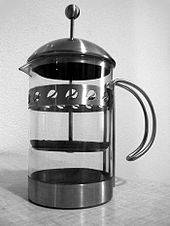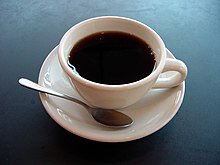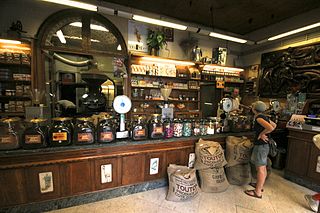
Italians are well known for their special attention to the preparation, the selection of the blends, and the use of accessories when creating many types of coffees. Many of the types of coffee preparation known today also have their roots here. The main coffee port in Italy is Trieste where there is also a lot of coffee processing industry. Italian coffee consumption, often espresso, is highest in the city of Trieste, with an average of 1500 cups of coffee per person per year. That is about twice as much as is usually drunk in Italy.

A French press, also known as a cafetière, cafetière à piston, caffettiera a stantuffo, press pot, coffee press, or coffee plunger, is a coffee brewing device, although it can also be used for other tasks. The earliest known device was patented in 1852 in France by Jacques-Victor Delforge and Henri-Otto Mayer.
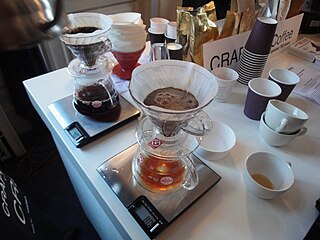
Drip coffee is made by pouring hot water onto ground coffee beans, allowing it to brew. There are several methods for doing this, including using a filter. Terms used for the resulting coffee often reflect the method used, such as drip-brewed coffee, or, somewhat inaccurately, filtered coffee in general. Manually brewed drip coffee is typically referred to as pour-over coffee. Water seeps through the ground coffee, absorbing its constituent chemical compounds, and then passes through a filter. The used coffee grounds are retained in the filter, while the brewed coffee is collected in a vessel such as a carafe or pot.

A coffee filter is a filter used for various coffee brewing methods including but not limited to drip coffee filtering. Filters made of paper (disposable), cloth (reusable), or plastic, metal or porcelain (permanent) are used. Paper and cloth filters require the use of some kind of filter holder, whereas filters made out of other materials may present an integral part of the holder or not, depending on construction. The filter allows the liquid coffee to flow through, but traps the coffee grounds.
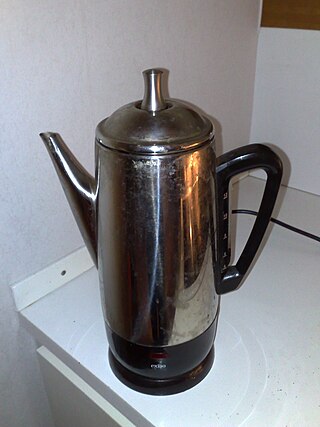
A coffee percolator is a type of pot used for the brewing of coffee by continually cycling the boiling or nearly boiling brew through the grounds using gravity until the required strength is reached. The grounds are held in a perforated metal filter basket.

An espresso machine brews coffee by forcing pressurized water near boiling point through a "puck" of ground coffee and a filter in order to produce a thick, concentrated coffee called espresso. Multiple machine designs have been created to produce espresso. Several machines share some common elements, such as a grouphead and a portafilter. An espresso machine may also have a steam wand which is used to steam and froth liquids for coffee drinks such as cappuccino and caffè latte.

A coffee cup is a container, a cup, for serving coffee and coffee-based drinks. There are three major types: conventional cups used with saucers, mugs used without saucers, and disposable cups. Cups and mugs generally have a handle. Disposable paper cups used for take-out sometimes have fold-out handles, but are more often used with an insulating coffee cup sleeve.

Coffee service refers to the many and various styles in which coffee is made available to people, such as in restaurants and hotels. In particular, it sometimes refers to the set of dishes and vessels utilized to serve and consume coffee, akin to the notion of a tea service.

The Neapolitan flip coffee pot is a drip brew coffeemaker for the stove top that was very popular in Italy until the 20th century. Unlike a moka express, a napoletana does not use the pressure of steam to force the water through the coffee, relying instead on gravity.
Bunn-O-Matic Corporation is an American manufacturer of dispensed beverage equipment headquartered in Springfield, Illinois, with a plant in Creston, Iowa. The company was founded in 1957 by George R. Bunn, who designed his own versions of equipment that had been in existence for nearly fifty years: paper coffee filters and pour-over drip coffee brewers. Today, the corporation's products are sold under the BUNN and Bunn-O-Matic brands. The company's home coffeemakers are used throughout the United States and Canada, but the company's primary customers are institutional foodservice providers worldwide. The company introduced their first automatic drip-brew coffee maker in 1963. The company introduced their first drip brewer for the home market in 1972. The current president and CEO is Arthur H. Bunn.

Coffee preparation is the process of turning coffee beans into liquid coffee. While the particular steps vary with the type of coffee and with the raw materials, the process includes four basic steps: raw coffee beans must be roasted, the roasted coffee beans must then be ground, and the ground coffee must then be mixed with hot or cold water for a specific time (brewed), the liquid coffee extraction must be separated from the used grounds, and finally, if desired, the extracted coffee is combined with other elements of the desired beverage, such as sweeteners, dairy products, dairy alternatives, or toppings.

A vacuum coffee maker brews coffee using two chambers where vapor pressure and gravity produce coffee. This type of coffee maker is also known as vac pot, siphon or syphon coffee maker, and was invented by Loeff of Berlin in the 1830s. These devices have since been used for more than a century in many parts of the world. Design and composition of the vacuum coffee maker varies. The chamber material is borosilicate glass, metal, or plastic, and the filter can be either a glass rod or a screen made of metal, cloth, paper, or nylon. The Napier Vacuum Machine by James Robert Napier, presented in 1840, was an early example of this technique. While vacuum coffee makers generally were excessively complex for everyday use, they were prized for producing a clear brew, and were quite popular until the middle of the twentieth century. Vacuum coffee makers remain popular in some parts of Asia, including Japan and Taiwan. The Bauhaus interpretation of this device can be seen in Gerhard Marcks' Sintrax coffee maker of 1925.

The moka pot is a stove-top or electric coffee maker that brews coffee by passing hot water driven by vapor pressure through ground coffee. Named after the Yemeni city of Mocha, it was invented by Italian engineer Luigi Di Ponti in 1933 who sold the patent to Alfonso Bialetti, an aluminum vendor. It quickly became one of the staples of Italian culture. Bialetti Industries continues to produce the original model under the trade name "Moka Express".
Alfonso Bialetti was an Italian engineer who became famous for introducing the Moka Express coffeemaker. Designed in 1933, the coffee pot has been a style icon since the 1950s. While many variations of the Moka have been developed, including the Bialetti cow-printed Mukka Express, the original remains a time-honoured classic. Bialetti was also the founder of Bialetti Industries, the now giant Italian kitchen-ware company.
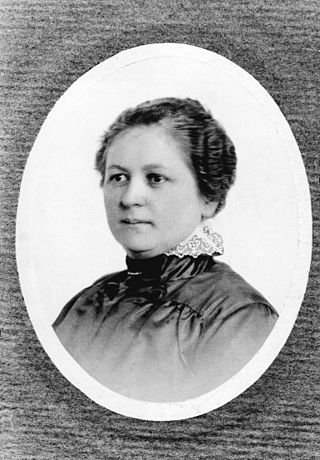
Amalie Auguste Melitta Bentz, born Amalie Auguste Melitta Liebscher, was a German entrepreneur who invented the paper coffee filter in 1908. She founded the company Melitta, which still operates under family control.

The AeroPress is a manual coffeemaker invented by Alan Adler, founder of AeroPress, Inc. It consists of a cylindrical chamber, and a plunger with an airtight silicone seal, similar to a syringe. Ground coffee beans and water are steeped inside, then forced through a filter at the bottom of the chamber by pressing the plunger down through the chamber. It is capable of brewing highly concentrated coffee, which the manufacturer describes as "espresso style", but can also be used to brew filter strength coffee, or cold brew coffee.

A single-serve coffee container is a container filled with coffee grounds, used in coffee brewing to prepare only enough coffee for a single portion. They come in various formats and materials, often either as hard and soft pods or pads made of filter paper, or hard aluminium and plastic capsules.

The Chemex Coffeemaker is a manual pour-over style glass coffeemaker, invented by Peter Schlumbohm in 1941, manufactured by the Chemex Corporation in Chicopee, Massachusetts.
"System Büttner" coffee makers have been a type of manual and semi-automatic coffee makers combining coffee steeping with drip-filtering.


